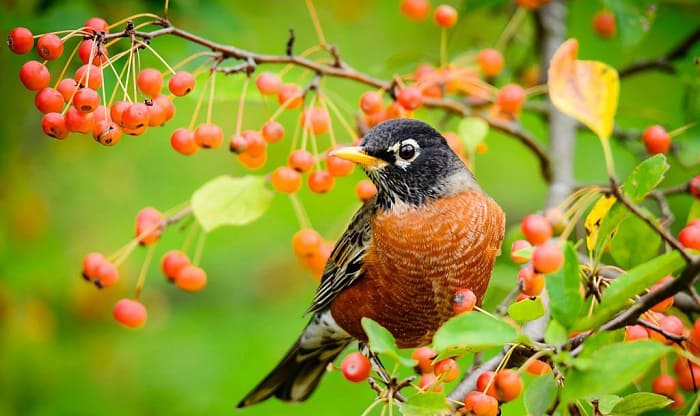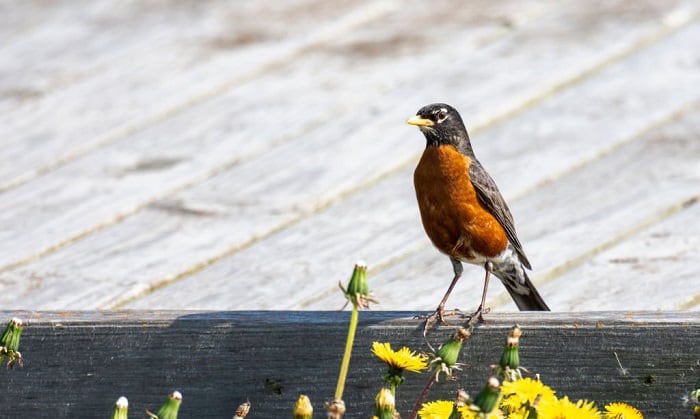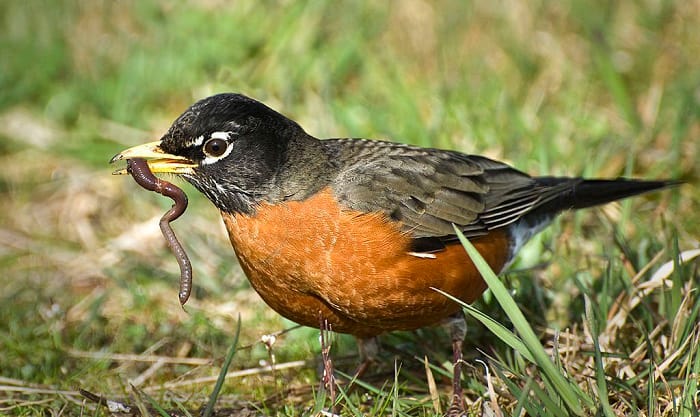Just like the other states, Connecticut has a set of symbols that represent and celebrate the qualities that set it apart from the rest. After all, despite being considered as one country, the fifty states of the Union have different laws, cultures, heritage, beliefs, and even floras and faunas.
The Mountain Laurel, Praying Mantis, Garnet, and the White Oak are the symbols adopted by the state of CT as its state flower, insect, mineral, and tree, respectively. But what is the state bird of Connecticut? Well, it is the American Robin.
Table of Contents
Why is the American Robin the State Bird for Connecticut?
Connecticut, also known as the Constitution State, is the fifth state to be admitted to the United States of America. It is also one of America’s original thirteen states.
Among the fifty States of America, Connecticut is the forty-eighth biggest state in terms of total area.
Although it is America’s third smallest state, it has established itself as a good birding location as there are more than four hundred thirty (430) species of birds in Connecticut. Steep hills, ridges and valleys, forests, and shoreline beaches are just a few of the diverse bird habitats that can be found in the State.
Considering the hundreds of bird species found on its coast line and birding hotspots, it is interesting how the Constitution State decided on its state bird.
In choosing their state bird, the United States usually picks the one that is either native or most common in their state. In Connecticut’s case, however, the bird that they picked as their state bird is neither the endemic or the most common bird.
In fact, the American robin only ranks fifth in the list of the most common Connecticut birds.
It is neither endemic or uniquely found in the State, as the American robin is a common backyard bird in America, and can be found all across the country.
So, how did the American robin earn its spot as Connecticut’s state bird? The answer is its loyalty.
The American robins found in Connecticut are deemed loyal by the people due to the fact that they do not leave the state especially during winter. Instead of migrating to warmer states such as Texas and Florida, the American robins stay in the State and settle on the swamps’ tall pines.
Getting to Know the American Robin
Among all Connecticut birds identification of the American robins can get a little tricky. Although often confused with any other brown and orange, or black and yellow bird CT’s state bird is actually unique on its own.
The American robin (Turdus migratorius) is a bird that can be found across North America, and certain parts of Central America. It got its name from the first European settlers in America, who saw that its color pattern was similar to the European robin (Erithacus rubecula).
However, the American robin and English robin are not closely related.
- It belongs to the Turdidae family, or family of thrushes.
- Measuring 9-11 inches, with a wingspan of 12-16 inches, the American robin is the largest thrush //in North America.
- They have long legs, round bodies, and tails that are longer than other thrushes.
- They have black heads, and yellow beaks. Brown feathers cover their back, and warm orange feathers on their chest. However, the feathers of the male American robins appear to be brighter compared to the females.
- American robins are diurnal birds– they are awake mostly during the day, and sleep at night.
During the daytime, they spend their time hunting for food. Due to the food they eat, the American robins can be found mostly in gardens, yards, woodlands, parks, backyards, and grasslands.
- The diet of the American robins include earthworms, berries, and insects. Earthworms serve as their main food, however, they rely on fruits, seeds, and berries during the winter.
- When hunting for food, the State bird of CT takes advantage of their monocular vision to spot their prey. They use their agility and speed to catch their food, even mid-air.
However, they also fall prey to other creatures such as squirrels, ravens, crows, owls, and raccoons.
- Due to the threats in their surroundings, the American robins do not live a long life. Some of them do not survive their first year, causing the high mortality among young American robins.
Don’t worry though! The International Union for Conservation of Nature has categorized the American robin as “Least Concern”, and is far from being extinct. With its population going up to about 370 million, the number of the American robins remains as one of the largest in North America.
When Did the American Robin Become the State Bird for Connecticut?
The United States of America began adopting state symbols after getting inspired by the World’s Fair’s “National Garland of Flowers” in 1893.
Since then, each state began recognizing icons and symbols that can best represent itself. More so, some states use this as a way to promote industries or attractions that are relevant to them.
For a symbol to be fully recognized, it has to undergo the Legislative process. The same process was observed when the American robin became the state bird of Connecticut. The American robin was adopted by the State of Connecticut as its state bird through legislation in 1943.
However, it was not only Connecticut that adopted the American robin as its state bird. Connecticut’s fellow Northern states, Michigan and Wisconsin also have the American robin as their state bird.
Fun Facts About American Robins
Fun Fact #1: American robins can tell themselves apart from other robins by the color of their chest feathers.
Fun Fact #2: In some states, sightings of American robin meaning spring is already on its way.
- The American robin bird symbol is often used to signify the coming of spring because the American robins are the first birds to return after migrating to other places for winter.
- However, not all American robins migrate during winter, just like those who are in Connecticut. Therefore, this fact is only app
Fun Fact #3: Belonging in the family of thrushes, the American robins are melodious songbirds.
- The American robins begin to sing early in the morning, around the same time as their early food hunt. They start singing even before sunrise!
- For male American robins, they use their songs to attract females for mating.
Fun Fact #4: Some American robins get “tipsy” especially during winter.
- Due to the absence of earthworms and insects during winter, American robins consume fruits that are often already fermented due to the cold. The fermented fruits contain a small amount of alcohol that intoxicates the birds.
Fun Fact #5: The American robins hatch from blue eggs.
- One of the interesting facts about robins is that female American robins lay blue eggs due to biliverdin, a bile pigment.
- The color of American robins’ eggs is known as robin egg blue.
Conclusion
The American robin is indeed a small, yet incredible bird. It is seen as a symbol of hope, and its songs uplift the spirit of those who can hear it. More so, it has proven itself worthy of becoming one of America’s beloved birds, and of course, as the State bird of Connecticut.
So, the next time someone asks you, “what is the state bird of Connecticut?”, proudly flaunt your knowledge about this humble thrush.
Moreover, discover other topics that are related to state birds:
- Oregon state bird and its facts.
- The symbol bird of Missouri.
- What is the state bird of Mississippi and why?

George and I became friends after a birdwatching trip with our new group. And we have been enjoying every adventure together. When he told me the idea of establishing a site that shares our experiences and fun, I immediately agreed. After trials and errors, here we have Thayerbirding.
















